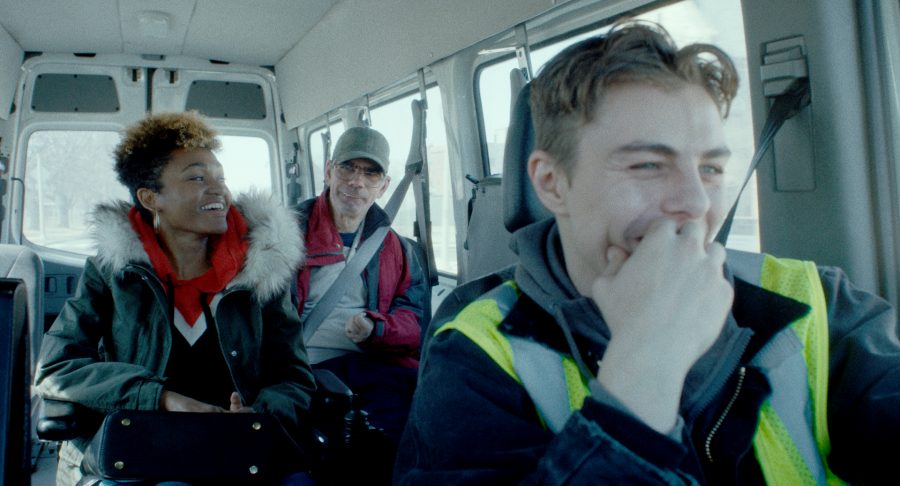“Give Me Liberty” never comes to a halt. From its title card to its final one, director Kirill Mikhanovsky doesn’t allow you to breathe, kidnapping the entirety of your being for a nonstop moony ride across the various districts of Milwaukee. Seeing as Vic (Chris Galust), our protagonist, is already running late before the movie even begins, we’re left playing catch-up with the film’s relentless gait while Vic furiously swerves from one destination to the next all the while promising his boss he’ll be there in “10 minutes tops.” Noting the ridiculous nature of his crusade, his promises to be on time serve as a reminder of the inherent faults in the bureaucratic, caregiving machinery he represents.
The film follows Vic’s attempts to appease the clashing agendas held by his bus’ eclectic congregation — a troupe of Russian mourners, an anarchic Russian boxer, a woman with ALS and an accordion player, among others — and as it progresses you begin to understand why Vic always has a cigarette jammed between his lips. Bombarded with hollering, complaints and absurd demands throughout the entire drive, amateur actor Chris Galust assumes a visage of stoicism that reflects his supreme ability to endure hardship for the sake of virtue. The no-nonsense look of his gaze, paired with Mikhanovsky’s decision to cast actual members of Milwaukee’s Russian immigrant community and students of the vocational training center for people with disabilities douse the film with a bona fide sense of realism that’s only heightened by Wyatt Garfield’s hyperactive handheld cinematography.
“Give Me Liberty’s” camerawork, combined with Mikhanovsky’s avant-garde editing style, fluidly interconnect in panic-inducing ways. The rapid cuts from a speeding bus to chanting bus riders with a flurry of colorful paintings stitched in between generate the reckless sensation of a diverted mindset that’s trying everything to stick with the plan and keep on track. It’s a sensation that bleeds out of the film’s veins, seeping into its characters’ commands, its plot’s direction and the story’s thematic agenda. Bursting from the film’s mania, these sparks of beautifully captured disarray speak to the essence of U.S. cinema as a brand that’s untethered from the trappings of tradition.
Abandoning the paradigms of conventional filmmaking, Alice Austen and Kirill Mikhanovsky’s script acts like a manifesto for a novel manner of portraying mundane mayhem. Ingrained within the reality of Mikhanovsky’s experience, “Give Me Liberty’s” heightened depiction of the mundane expounds reality’s hidden truths by adapting them into a story. This singular stroke of genius renders each moment in the film all the more resonant, as each abrasive cut manifests itself aggressively within your own headspace. As the film unfolds and your mind is assaulted by a barrage of ideas, you’re bound to teeter at the edge of a sensory overload until “Give Me Liberty” abruptly comes to a close.
Excising the artistry of authenticity from the director’s own experience as a medical transport driver, “Give Me Liberty” celebrates learning at the hands of misery. For all its unruliness, this stoic thread imbues the film with a transcendent sageness that makes every unplanned stop feel right. Suddenly, Chris’s rapid driving makes sense and you find yourself clamoring for him to accelerate. In an odd twist of sorts, the film’s brimming madness begins to make sense as a reflection of reality. Utterly democratic and unpatronizing in its depiction of people, motives and actions, “Give Me Liberty” is a modern masterwork that gathers the voices of its Milwaukee melting pot into a vehicle for change in the conventions of U.S. cinema.
Email Nicolas Pedrero-Setzer at [email protected].

























































































































































